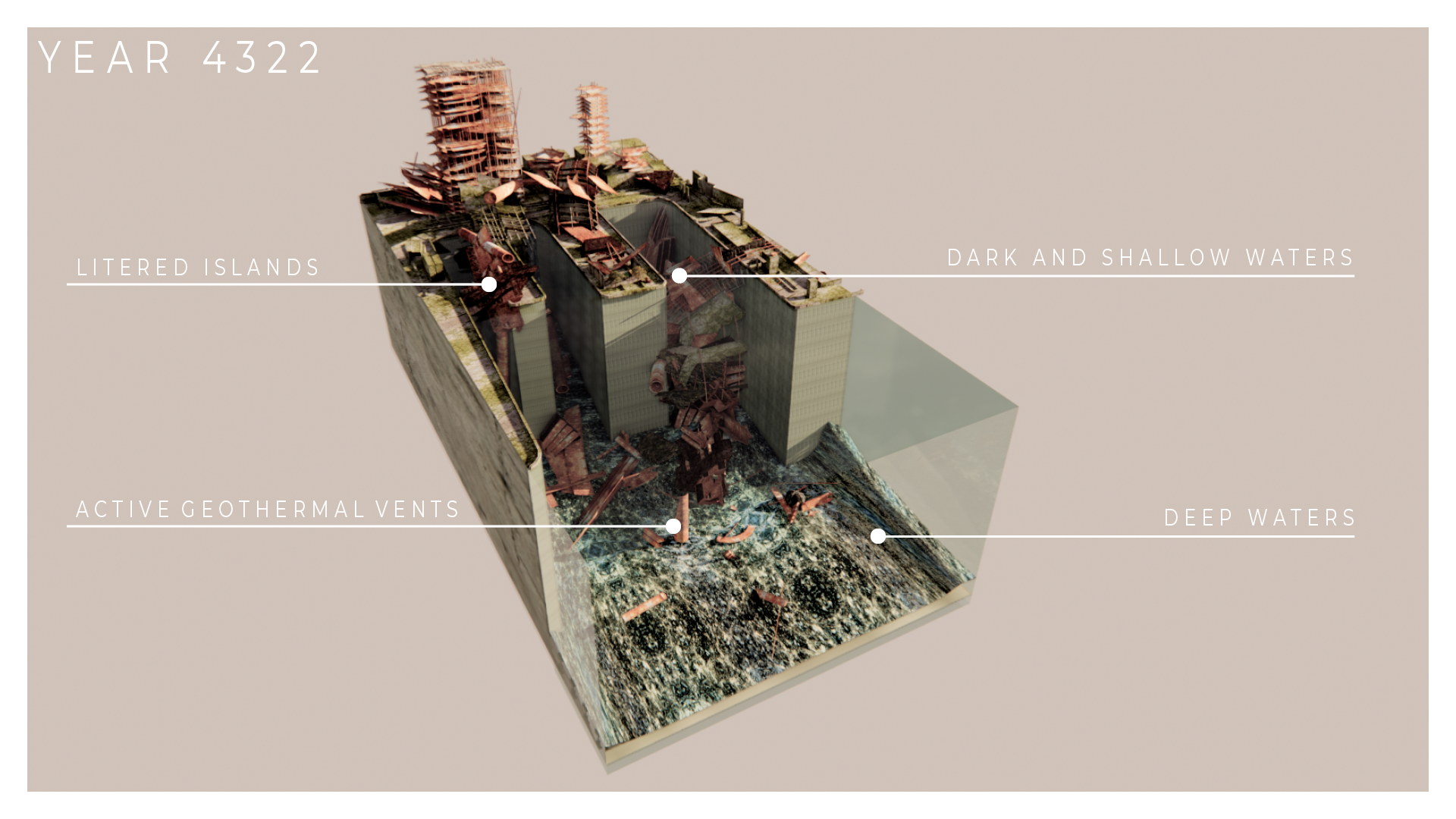Armando Macias Gutierrez
Manufactured Ecologies in the Post Anthropocene:
Manufactured Ecologies in the Post Anthropocene:
Auckland Snapper Turtle
The Auckland Snapper Turtle, also known as Caretta Serpentina, is among the most dangerous coastal predators in the Anthropocene remnants of Auckland. Following the wreckage that wiped out the city of Auckland in the year 2322. A large group of loggerhead turtles who once travelled worldwide to find breeding partners and nesting grounds have found a sustainable ecosystem that satisfies their daily and life-cycle needs. Fast forward 2000 years into the future. The coastal environment consists of overgrown rubble, remnants of cracked concrete slabs, rusted steel panels, I-beam, steel tubes, glass and rebar that long ago made up our built world and the refineries that once powered the entire city and beyond with renewable energy. While increasing the temperature of Auckland's coastal waters, the active geothermal vents also cause a bed of fog to form over this ecosystem. The littered islands make the coastal waters shallow and prevent much light from reaching the bottom. Thanks to the warm temperatures of the water, vent-microbes, and the excessive amount of shelter provided by the wreckage, a sustaining ecosystem exists that can provide the food and shelter necessary to many species, including bioluminescent flora and fauna.
Given this new environment, the loggerhead turtle became more static and picked up characteristics more commonly known as a snapper turtle or an alligator snapper turtle. The shell of this species has evolved to a less aerodynamic shape because the ones with more defined spikes and tough camouflage skin became less targeted by predators. Because this turtle becomes extremely large and heavy when it grows up, it slowly becomes less active in life. However, to help it navigate the shallow and often tight spots within the wrecked coast of Auckland, this species' limbs have also evolved to become more terrestrial. To survive, this species learned to feed without having to chase prey. The ones with strong and more defined jaws and beaks survived and eventually grew bioluminescent whiskers to attract prey and navigate the dark waters.
Given that the female Auckland coast turtle needs to nest her eggs in a dry burrow near water, the female relies on the tide movement to come in and out of the water during the breeding season. When the female is ready to nest a clutch, she will wait for the high rise and swiftly swim over to land to find a safe spot to burrow, nest, and return to the water before the tide gets too low.
The temperature of the burrow determines the sex of the turtles. The egg and hatchling are the most vulnerable stages in life as they are tiny in size and have none to very little defense mechanisms. The hatchling's sharp spikes might keep smaller predators away, but it is no match for large predators like coastal birds or the tuatara. However, once they mature, they are so large that they are barely preyed upon. Most of their physiological evolution has to do with the ease of mating, navigating and feeding in the new environment.
The Auckland turtle finds themselves alone at every turn in their lives. This comedy trailer for ""Mr. Lonely"" is meant to capture these creatures' independence and predatorial nature while displaying some of their vulnerability in the early stages of life.
Given this new environment, the loggerhead turtle became more static and picked up characteristics more commonly known as a snapper turtle or an alligator snapper turtle. The shell of this species has evolved to a less aerodynamic shape because the ones with more defined spikes and tough camouflage skin became less targeted by predators. Because this turtle becomes extremely large and heavy when it grows up, it slowly becomes less active in life. However, to help it navigate the shallow and often tight spots within the wrecked coast of Auckland, this species' limbs have also evolved to become more terrestrial. To survive, this species learned to feed without having to chase prey. The ones with strong and more defined jaws and beaks survived and eventually grew bioluminescent whiskers to attract prey and navigate the dark waters.
Given that the female Auckland coast turtle needs to nest her eggs in a dry burrow near water, the female relies on the tide movement to come in and out of the water during the breeding season. When the female is ready to nest a clutch, she will wait for the high rise and swiftly swim over to land to find a safe spot to burrow, nest, and return to the water before the tide gets too low.
The temperature of the burrow determines the sex of the turtles. The egg and hatchling are the most vulnerable stages in life as they are tiny in size and have none to very little defense mechanisms. The hatchling's sharp spikes might keep smaller predators away, but it is no match for large predators like coastal birds or the tuatara. However, once they mature, they are so large that they are barely preyed upon. Most of their physiological evolution has to do with the ease of mating, navigating and feeding in the new environment.
The Auckland turtle finds themselves alone at every turn in their lives. This comedy trailer for ""Mr. Lonely"" is meant to capture these creatures' independence and predatorial nature while displaying some of their vulnerability in the early stages of life.






